Is Tension with North Korea Reaching a Boiling Point?
🔍 Historical Context of North Korean Relations
The complicated relationship between North Korea and the international community has evolved over decades since the end of the Korean War in 1953. What began as a frozen conflict has periodically thawed into moments of crisis and negotiation.
Understanding today's tensions requires examining the historical patterns that have shaped North Korean foreign policy and the responses from major powers like the United States, China, and South Korea.
The isolationist regime in Pyongyang has consistently used provocations followed by negotiations as a strategy to gain concessions from the international community. This cycle has created a predictable yet dangerous dynamic.
For more historical background, check out this detailed timeline from the Council on Foreign Relations.
The Kim dynasty has maintained power through three generations, with each leader continuing the policy of military prioritization despite economic hardships.
| Korean War Legacy | DMZ Tensions |
| Armistice Agreement | Juche Ideology |
| Hereditary Leadership | Militarization Policy |
| Cold War Politics | Isolationist Strategy |
Recent statements from North Korean leadership have raised new concerns, as detailed in this BBC coverage of East Asian affairs.
Military analysts continue to monitor the situation closely, with organizations like the 38 North project providing specialized insights.
🚀 North Korea's Nuclear Program Development
North Korea's nuclear ambitions date back to the 1960s, but the program accelerated dramatically in the early 2000s. The country conducted its first nuclear test in 2006, shocking the international community despite years of warnings from intelligence agencies.
Each subsequent test has shown increasing sophistication in North Korea's nuclear capabilities.
Experts from the Arms Control Association estimate that North Korea may possess between 20-60 nuclear warheads, though exact numbers remain difficult to verify.
📊 The parallel development of ballistic missile technology has been equally concerning, with tests demonstrating potential intercontinental reach.
For comprehensive analysis of North Korea's missile capabilities, the CSIS Missile Defense Project provides detailed technical assessments.
🤝 Failed Diplomatic Initiatives
The Six-Party Talks (2003-2009) represented the most substantial multilateral effort to address North Korean denuclearization, involving North Korea, South Korea, Japan, China, Russia, and the United States.
Despite moments of progress, these talks ultimately collapsed, with North Korea withdrawing and expelling international inspectors in 2009.
More recent diplomatic initiatives, including the Singapore Summit between Kim Jong-un and Donald Trump in 2018, generated headlines but produced few concrete results. Learn more about this historic meeting from the Wilson Center's analysis.
| Nuclear Warheads | Ballistic Missiles | Uranium Enrichment |
| Satellite Launches | ICBM Tests | Nuclear Facilities |
| Six-Party Talks | Diplomatic Breakdowns | International Sanctions |
| Summit Diplomacy | Nuclear Non-Proliferation | Military Posturing |
⚠️ Recent Escalations and Provocations
The past year has seen a marked increase in provocative actions from North Korea, including multiple short and medium-range missile tests over the Sea of Japan.
Analysts at International Crisis Group suggest these actions may be designed to gain leverage for future negotiations or to test the resolve of regional powers.
🌎 International Response and Sanctions
The United Nations Security Council has passed numerous resolutions condemning North Korea's weapons programs, implementing increasingly strict economic sanctions. For comprehensive details on these sanctions, visit the UN Security Council Sanctions Committee.
However, the effectiveness of these measures has been limited by inconsistent enforcement, particularly along the Chinese border.
Conclusion: Are We at a Boiling Point?
While tensions with North Korea have certainly escalated in recent months, the situation likely hasn't yet reached a true "boiling point." The cyclical nature of North Korean provocations suggests current actions may be part of a familiar pattern rather than a prelude to conflict.
However, miscalculation remains the greatest risk factor. As weapons systems become more advanced and reaction times shorter, the margin for error in crisis management shrinks accordingly.
The international community must remain vigilant while pursuing pragmatic diplomatic engagement that acknowledges security concerns on all sides. The Asia Society Policy Institute offers thoughtful analysis on potential paths forward.
Frequently Asked Questions
| Does North Korea have the capability to strike the United States? | While North Korea has tested ICBMs with theoretical range to reach parts of the US mainland, questions remain about their reliability and re-entry capabilities. For expert assessment, consult Nuclear Threat Initiative. |
| What role does China play in managing North Korean tensions? | China remains North Korea's largest trading partner and has significant influence, though Beijing's willingness to pressure Pyongyang has limits based on its own strategic interests. See the Council on Foreign Relations for more on this complex relationship. |
| Could another summit between North Korean and US leadership help reduce tensions? | While high-level diplomacy can create opportunities for progress, past summits suggest that without substantial preparation and realistic expectations, such meetings may generate headlines without sustainable results. |









Comments
Post a Comment